
Mammoth & Petroleum Spawned Languages
We live in a world where most of our MATERIAL CULTURE now is made from PETROLEUM. Names of different types of synthetics and plastics and fuels make a big part of our lexicon.
In the 19th Century much of the MATERIAL CULTURE and lighting fuel was provided from WHALES. For about 10,000 years MATERIAL CULTURE of our ancestors was based on AGRICULTURE. Prior to 10,000 years ago much of the MATERIAL CULTURE was produced from MAMMOTHS. Metals such as copper, tin, bronze, lead. iron and eventually steel greatly supported the agricultural, whaling, and petroleum industries. Modern day Nimrods still enjoy sharing hunted game with friends. We eat our bread from grains grown by farmers. Few diehards still do (politically incorrect) whaling. Petroleum (and natural gas & lesser fossil fuels) now provide the raw materials for fertilizers, plastics, explosives etc. for the “vestigial industries” of ages past. The focus of this paper is the fact that the major industries of PETROLEUM, METALLURGY, WHALING, AGRICULTURE and INDUSTRIAL SCALE MAMMOTH HUNTING each left MAJOR LINGUISTIC IMPACT on LANGUAGES of the WORLD. Linguists today are exploring the possibilities of finding TransEurasian Mother Tongues and I hope to add my observations to the Babble. “SLONIAN” is what I wish to dub the PALEOLITHIC LINGUA FRANCA which still gives us many international words associated with body parts and Iconic features of Mammoths.
Methodology: We rely heavily on Czech (very Modern) and Slovenian (Archaic) and other Slavic languages (synonymous with Proto-Indo-European) and on Modern English the PolyGenic Indo-European Language of 21st Century Science.
One of the many words for “ELEPHANT” in India is SR NI which is similar to the Slavic word for Elephant: SLON. In Russian the word for “elephant” is слон – Female = слониха (SLONIKHA). In Ukrainian the word for elephant is слон – Female = слониха. in Belarusian it is слон – Female = сланіха, in Slovenian it is SLON in Slovak = SLOŃ in Polish = SŁOŃ, in Czech= SLON, The Sorbian words for elephant are similar to the Czech and Polish forms. The Croatian word is SLON, the Bosnian is SLON, Serbian = слон, Bulgarian = слон, Macedonian = слон. In all dialects of Slovenian in Italy, Austria Hungary etc. the words for elephant are always SLON with negligible differences in palatalization and stress. The SLON root is also present in the Baltic (Balto-Slavic) language of Latvian where the word for elephant is ZILONIS. The surprising thing is that the AMHARIC – Ethiopian word (in the Horn of Africa) is similar to the Balto-Slavic Latvian word for elephant = ZILONIS. ZIehON (ዝሆን) is the Ethiopian Amharic word for elephant. In Hebrew SILONI or SILONIT describe elephant-like Fourth Plague upon Egypt. In Chinese the word for elephant is – sδaŋ and in South China and Taiwan it is sδoŋ. The Laosian word for elephant is Saŋ (SANg), Thai = (CHANg) Čaŋ, Mongolian – ZAAN, Tibetan = GLAN, Japanese – ZO (or ZOsan. Additionally the root SLON appears in other words associated with elephants. Finnish word for IVORY is: norSUNLuu. Korean word for IVORY is SANG-A. In North America Mythological Gigantic Ogreses are described as being elephant-like and they are named TSONOQUA, DZUNNUKWA, DZOO-NOO-QUA, DZOONOKWA, TSUNOKWA DZONOKWA etc. sounding like female elephants in Slavic languages.
We propose that the PETROLEUM Industry tapped English (with Greek & Latin roots) for neologisms for names of plastics and other synthetic materials we use in everyday life in the 20th and 21st Century — In the PALEOLITHIC the dominant industry and economy was based on MAMMOTHS and their FIBROUS WOOL COAT, their HUMAN-like Vertical SKULL with large CRANIUM and REAL CHIN… their TUSKS and other teeth, their BONES and Pachyderm SKINS, the MAMMOTH FLESH and FATS, and their salted and smoked MEATS and even their DUNG as FUEL and smoldering INSECT REPELLENT. While it is possible for an individual to hunt down a whale or an elephant, it is more likely to be a communal effort requiring language, planning and cooperation of a cartel.
We propose that the names of anatomical features of mammoths and humans have similar names in Indo-European languages because they are based on jargon of cartels of Mammoth Hunters and tradesmen and artists and artisans who processed and marketed quality products made from mammoths — ALL OVER THE WORLD…. ERGO they profoundly influenced the languages, cultures, mythologies, religions and Weltanschauung of the world.
Here are some similar Slavic and English words from our distant past.
| OKO | EYE more conspicuous similarity on the word OCULAR |
| NOS | NOSE |
| BRADA | BEARD (Chin) |
| SRDCE | HEART |
| SOL | SALT for curing meat |
| PLAMEN | FLAME for processing meats |
| DYM | SMOKE for curing meat. DIM produced SHADOW >> S’EDY’ = GRAY |
| MASO | MEAT and by extension any MASSive substance (Masivni) |
| DRVO | as in DRVID > DRUID (tree worshiper) > TREE/WOOD for Smoking meat products |
| KOST | OSTeo… > dealing with BONE |
| Z’AR | CHARing meat for a meal |
| ROZ’EN’ | ROAST |
| SADLO | SUET > LUJ > OLEJ > OIL |
| PEKAR | BAKER (baking meat) |
| JATRA | LIVER |
| LEDVINA | KIDNEY |
| NIT | KNIT from mammoth’s long wool |
| VLNA | WOOL from mammoth’s long hair
As the fibers of mammoth long wool was used in knitting and weaving a BINARY mathematical system of “OVER” & “UNDER” was needed. In Slavic languages this is evident in that the NUMERALS RHYME BY TWOS. NOTA BENE: Czech numerals rhyme by twos: jednA dvA, tŘI čtyŘI, pĚT šEsT, sed’M os’M, DEvĚT DEsET |
There are times when well meaning critics wish to correct the counting to: jedEN – dvA – which would not rhyme.
The answer is: in Czech one does not count dvacet jedEN, dvacet dvA, padesát jedEN
padesát dvA… but dvacet jednA dvacet dvA, padesát jednA šedesát jednA… 71 72, 91 92… 201 202. Such counting is effective for basketry and weaving, for punch cards used by automaton looms and in computer science in the form of 001101000111…
We also must focus on the fact that all extant Indo-European languages have names of numerals similar to the Slavic numerals, but Alas without the rhyme as with (three=tři seven=sed’m).
Bibliography:
International Journal of Social Science Studies Vol. 6, No. 2;
February 2018 ISSN 2324-8033 E-ISSN 2324-8041
Published by Redfame Publishing URL: http://ijsss.redfame.com
Mythological Beings Based on Mammoths
Petr Jandáček1
1127 La Senda Rd. (Los Alamos), White Rock, New Mexico87547,USA
Correspondence:
Petr Jandacek, 127 La SendaRd. (Los Alamos), White Rock, New Mexico 87547, USA.
Received: November 21,2017
Accepted: December 8, 2017
Available online: January 5, 2018
DOI: 10.11114/ijsss.v6i2.2915
URL: https://doi.org/10.11114/ijsss.v6i2.2915
Words for the Animal Elephant / Mammoth in Relation to the DNA Genealogy Data
Petr Jandáček1, Anton Perdih2*
DOI: 10.4236/aa.2017.74014
https://doi.org/10.4236/aa.2017.74014

Petr Jandacek
(505) 672-9562
Petr Jandacek
Louise Jandacek
Mailing Address
127 La Senda Road
Los Alamos, New Mexico
USA
87544


